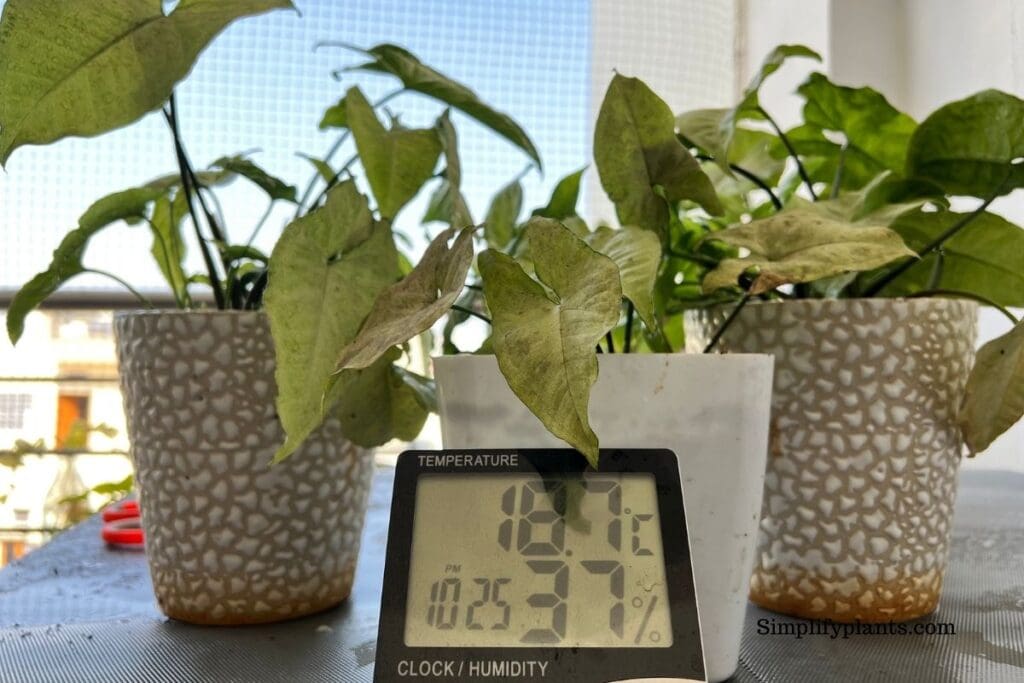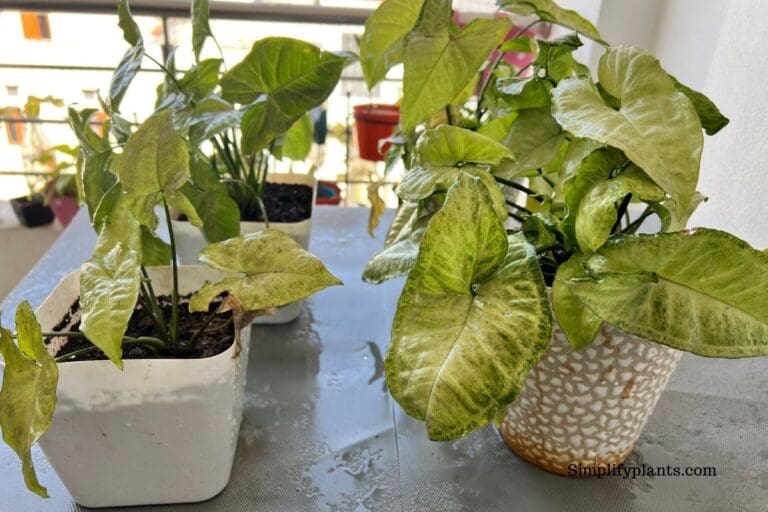How Fast Do Arrowhead Plants Grow? (Arrowhead Plant Growth Rate)
The arrowhead plant or Syngonium is a popular houseplant that comes from the tropical rainforests of Central and South America. If you have brought a new Syngonium or are planning to get one for your indoor space, you might wonder how fast they grow.
Let’s find out what is the average growth rate of an arrowhead plant.
In general, Arrowhead plants are fast-growing plants that can grow up to 15 inches in a year. They grow dense and bushy vines as they mature. Syngonium thrive when they receive bright light, warm conditions, and high humidity, but the growth slows down in the absence of these.
You might need to prune your arrowhead plant 3-4 times to keep it in shape.
However, you might notice a drop in its growth during winter as it is the dormant period for these plants when they conserve their energy and rest instead of focusing on growth.
In this article, I will discuss the factors that affect the growth of your Syngonium and mention some ways of encouraging it to grow faster.

Please note: Simplify Plants is reader-supported. Some links in the post are affiliate links and I get a commission from purchases made through links in the post.
Factors that affect the growth of arrowhead plants
Many factors determine the growth of arrowhead plants. Let’s understand how they affect your Syngonium.
- Light
- Watering
- Soil
- Fertilization
- Temperature and humidity
- Season
- The pot size
- Pest infestation
- Pruning
- Adaptability
Now, let’s dive into the details.
Light

Light is essential for the growth and survival of all plants.
One good thing about arrowhead plants is that they can adapt to various lighting conditions.
However, low light can reduce the growth rate of your Syngonium.
The variegated varieties require bright light, whereas the greener ones can survive in low-light areas such as offices and dorms.
But if you notice that your arrowhead plant is not growing as fast, consider the lighting conditions and provide brighter light if it is not getting enough.
If your house lacks enough natural light, you can use artificial lights.
Don’t place your arrowhead plant under direct sunlight, as the leaves will get scorched, and the plant’s health and growth will be affected.
Also read: Arrowhead Plant Light Needs: What Type, How Much & More
Watering

Watering your arrowhead plant might seem a little tricky, but once you understand the requirement, you can master it.
Excess water can cause serious harm to your Syngonium by causing diseases such as root rot.
On the other hand, underwatering that makes the soil dry will also prevent the plant from growing.
In general, the arrowhead plants require watering 1-3 times a week during the growing season, depending on other external factors.
How to water the arrowhead plant correctly?
The following steps will guide you to water your arrowhead plant correctly, ensuring healthy growth.
- Always check the soil and make sure it is 50-75% dry before watering your Syngonium.
- You can get a moisture meter or insert your finger a few inches into the soil to determine the moisture level.
- If the soil feels wet, allow it to dry for more days.
- You can use a calendar that will remind you to check your arrowhead plant’s soil moisture. This way, you will not underwater the plant.
- Use a well-drained potting mix that will not retain excess water and make the soil soggy.
- Use a clay or terracotta pot to wick away the excess moisture.
- Make sure the pot has drainage holes.
- Reduce the watering by half in the winter season as the plant remains dormant during this time.
Also read: How To Water Arrowhead Plant? (How Often+Summer & Winter)
Soil

The type of soil you use for your Syngonium can also determine the plant’s growth.
Without the right soil, the plant will develop various problems that restrict growth and affect the plant’s health.
If your arrowhead plant is not growing fast enough, check the potting mix and find out if it is suitable for the plant.
If the potting mix is too heavy, it will retain excess moisture and affect the roots of your Syngonium.
This can lead to the deadly root rot disease, which affects growth and can also kill the plant.
But if the soil can’t hold sufficient moisture, the roots will not absorb water or nutrients, making the plant weak and preventing growth.
Therefore, you should use a well-drained and fertile potting mix to allow proper drainage, retain enough moisture, and encourage airflow.
An ideal soil recipe for your Syngonium would be:
- 2 parts potting soil
- 1 part charcoal and pumice
- 1 part coco coir
Also read: What Kind Of Soil For Arrowhead Plant? (+Best Soil Mix)
Fertilization

Fertilizers provide all the required nutrients to the plants and encourage growth.
Therefore, fertilization is an important factor determining your arrowhead plant’s growth.
If you don’t give enough fertilizers or don’t fertilize your Syngonium at all, it will still survive, but its growth rate will reduce.
The soil doesn’t retain all the nutrients it held when you first prepared it, and the nutrients don’t get replenished naturally like in the wild.
This is why fertilization becomes necessary for plants.
On the other hand, overfertilization can also reduce growth instead of boosting it.
Many plant-owners believe that adding more fertilizer to their plants can make them grow faster, so they end up overfertilizing their plants.
Overfertilizing does more harm than good for the plants.
It can burn the roots, affecting the overall health and growth of the plant.
Fertilizing your Syngonium in the winter season can also lead to overfertilization as they remain dormant during this time and don’t use the fertilizer.
The unused fertilizers lead to a salt buildup on the soil that damages your plant.
Therefore, you should fertilize your Syngonium once a month during the growing season and avoid fertilizing in the winter season.
If you have an overfertilized arrowhead plant, follow these steps:
- Stop fertilizing immediately.
- Prune all the damaged foliage.
- Check the roots and remove the damaged ones.
- Scrape the soil to get rid of the excess salt.
- Repot the Syngonium with a fresh potting mix if required.
Also read: How Often Should You Fertilize Arrowhead Plant? (Best Fertilizer For Arrowhead)
Temperature and humidity

Arrowhead plants require warm conditions with high temperatures and humidity.
The plant will grow at the usual rate when it gets suitable temperatures and humidity.
But, if the temperatures and humidity remain too low or high for the Syngonium, its growth will get affected.
Winter comes with low temperatures and low humidity levels that are unfavorable for the growth of arrowhead plants which is why they go dormant.
Although Syngoniums will not grow during winter but will need special care for survival.
Here are a few tips for maintaining the correct temperature and humidity levels for your arrowhead plants.
- Keep your arrowhead plant in a well-insulated room.
- Avoid placing it near a radiator, heater, furnace, or other heating sources.
- Don’t keep your Syngonium near doors and windows closed and opened frequently as it will cause temperature fluctuations.
- Don’t keep your arrowhead plant opposite to the AC as the dry air will stress the plant.
- Install a humidifier or prepare a pebble tray to increase the humidity around the plant.
- Avoid exposing your arrowhead plant to hot or cold drafts and frost during winter.
Also read: Do Arrowhead Plants Like Humidity? (+Misting?)
Season
Don’t worry if you don’t notice any growth in your arrowhead plant during the winter season.
The plant will grow actively in the summer and spring seasons as the temperature, humidity, and other external conditions are ideal for its growth.
But in winter, the duration and intensity of sunlight reduce along with a decrease in the temperature and humidity levels.
This situation doesn’t encourage growth in your Syngonium and forces it to go dormant.
Therefore, you should wait for the growing season to see growth in your arrowhead plant.
- Avoid fertilizing your Syngonium in winter.
- Reduce watering to half.
- Use artificial lights if the plant isn’t getting enough natural light.
- Protect the plant from frost, cold drafts, and low temperatures during winter.
The size of the pot

The growth of your arrowhead plant can also depend on the size of its pot. Here’s how:
If you plant your Syngonium in a small pot, it will become rootbound quickly.
A rootbound state doesn’t allow the roots or the plant to grow freely.
The roots also fail to function due to lack of space and displace the soil for more space.
All these conditions don’t allow the plant to receive enough water or nutrients, and thus, the plant fails to grow.
However, that doesn’t mean you’ll use an oversized pot, as that can also restrict growth.
- An oversized pot will hold more soil which will retain more water, and this can cause overwatering.
- The Syngonium will focus on root growth than foliage growth in an oversized pot.
Therefore, you must choose a pot that is one size bigger than the plant if you want it to thrive.
Pest infestation

Pests can largely affect the growth of your Syngonium in a bad way.
Pests attack plants that are not in their best health.
So, if you notice slow growth in your arrowhead plant, inspect it thoroughly as pests tend to hide on the undersides of leaves.
Overwatering, underwatering, low light, low humidity, etc., are common reasons behind pest infestations.
Pests feed on the sap of the plants that contain the nutrients that the plant needs.
Therefore, the presence of pests makes your plant weak and vulnerable to different health problems, including slow growth.
Mealybugs, aphids, scales, spider mites are common pests found on houseplants.
If you notice any of these on your arrowhead plant, here’s what you should do:
- Isolate the arrowhead plant to prevent the spread of these pests to other plants.
- Inspect the plant thoroughly and prune the heavily infested areas.
- Handpick the visible pests.
- Give the Syngonium a good shower to remove the pests from the plant.
- Use a neem oil spray to spray the entire plant and continue this for at least 2 weeks till the pests leave the plant.
- If the pests still don’t go away, get a pesticide from the market and spray it on your plant. But go through the instructions carefully, so you don’t make any mistakes.
- Keep the plant under bright indirect light and allow it to recover.
Pruning

Arrowhead plants can grow fast and require pruning 3-4 times a year to control their growth.
Pruning helps to remove the unwanted parts that waste the plant’s energy and encourages new growth.
However, if you don’t prune your Syngonium on time, it will grow messy and leggy and not show proper growth.
Therefore, don’t skip pruning as it is an essential part of the care routine of Syngonium.
Keep these in mind while pruning your Arrowhead plant
You must consider the following while pruning your arrowhead plant to avoid making mistakes that can damage the plant.
- Try pruning your arrowhead plant in the summer or spring seasons.
- Avoid pruning in the winter season as it can be stressful for the plant.
- Always use sharp and disinfected pruners to do the pruning.
- Wear gloves while pruning to protect your skin.
- Prune the dead and diseased leaves and stems.
- Prune the leggy and overgrowth.
- Water your plant thoroughly and provide bright indirect light to it after pruning.
Adaptability
The arrowhead plant might require some time to adjust after you’ve brought it home for the first time.
So, you might not notice fast growth after bringing it home.
The plant’s adaptability to changes can also affect its growth.
If you make sudden changes to your arrowhead plant, it might not react well and take a lot of time to recover from that stress.
Therefore, consider making gradual changes and taking proper care of the plant to help it recover, adjust and grow.
How do you make Syngonium bushy?

You can make your arrowhead plant grow faster and become bushier by providing the right care.
Here’s a table that shows you the ideal requirements of these plants so you can take better care and encourage them to grow bushy.
| Factors | Correct Care Tips |
|---|---|
| Light | Bright indirect light is most suited. However, the less variegated varieties can tolerate lower lighting conditions. |
| Water | You should water your arrowhead plant after checking the soil’s moisture and ensuring that 50-75% of it is dry. |
| Soil | Use well-drained and fertile soil for your arrowhead plant. |
| Fertilizer | Fertilize your Syngonium with a 10:10:10 or 20:20:20 fertilizer during the growing seasons. Avoid fertilizing in winter. |
| Temperature | Maintain warm temperatures between 65-80°F during the day and above 60°F at night. |
| Humidity | Try to provide over 60% humidity to these plants and don’t let it drop below 40-50%. |
| Repotting | Repot your arrowhead plant whenever it shows signs of rootbound. Use a pot that is one size bigger than your arrowhead plant. |
| Pruning and pinching | If you want to promote bushier growth, you must prune and pinch it frequently. |
Recommended Garden Supplies
| Product Image | Our Recommended Gardening Supplies | Check Offers! |
|---|---|---|
Top Top
Top
Top
Top
Top
Top
Top
Top | rePotme Houseplant and Tropical Classic Potting Soil Mix | Check Offer On Amazon |
 Top
Top
Top
Top
Top
Top
Top
Top | Espoma Organic Indoor Plant Food | Check Offer On Amazon |
 Top
Top
Top
Top
Top
Top
Top
Top | GooingTop LED Grow Light 6000K Full Spectrum Clip Plant Growing Lamp | Check Offer On Amazon |
 Top
Top
Top
Top
Top
Top
Top
Top | Soil Moisture Meter | Check Offer On Amazon |
 Top
Top
Top
Top
Top
Top
Top
Top | Govee Hygrometer Thermometer, Bluetooth Enabled! | Check Offer On Amazon |
 Top
Top | LEVOIT Humidifiers for Large Room(Best For Plants) | Check Offer On Amazon |
 Top
Top
Top
Top
Top
Top
Top
Top | Upgraded DIY Automatic Drip Irrigation Kit, 15 Potted Houseplants Support | Check Offer On Amazon |
 Top
Top
Top
Top
Top
Top
Top
Top | Stainless Steel Heavy Duty Gardening Tool Set | Check Offer On Amazon |
 Top
Top
Top
Top
Top
Top
Top
Top | Bonide Insecticidal Soap | Check Offer On Amazon |
 Top
Top
Top
Top
Top
Top
Top
Top | Bonide 32 oz Spray Neem Oil for Organic Gardening | Check Offer On Amazon |
 Top
Top
Top
Top
Top
Top
Top
Top | Garden Safe Fungicide | Check Offer On Amazon |






